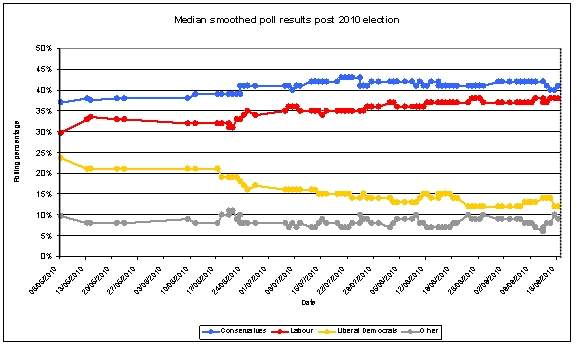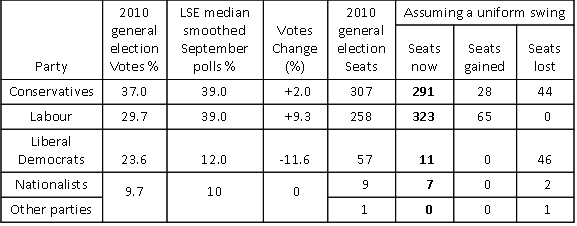As political trends snap into sharp focus next week with the crowning of the new Labour leader, the party is already level-pegging with the Conservatives again, and the edge has for the moment gone off the Tories’ poll ratings. Meanwhile Patrick Dunleavy and Chris Gilson find that Liberal Democrat support has halved and the party would face electoral extinction if an election was held tomorrow.
No wonder Nick Clegg could not bear to sit out the whole of his party conference with the rest of the delegates. The event has been a disaster in coverage and public opinion terms, with the party receiving few top headlines and no noticeable boost in recent polls. As our first chart shows, at 12 per cent its polling support is now running consistently at a half of the Liberal Democrats’ election support (itself a sad decline on the heady days of Clegg’s TV debate surges when the party was rating in the 30s for a while).

Note: Median smoothing is a technique that controls for the dips and wobbles of individual polls.
Meanwhile Labour support has continued its steady revival, achieving parity with the Conservatives recently, despite the inter-regnum of the party’s not very exciting leadership competition. Whichever of the Miliband brothers emerges as the leader this weekend, the party looks set to reap many more (and many more favourable) headlines than the Liberal Democrats’s meagre ration. Especially if Ed Miliband emerges as the victor, who is relatively unknown as yet to the wider electorate, Labour can expect a large ‘honeymoon’ bounce, but one that may not outlast the onset of the Tories’ conference week.
For the Conservatives, July and August brought some heady scores into the lower 40s, perhaps reminding party optimists that its average election vote share across the whole twentieth century was a commanding 44 per cent. Yet as the economy falters under the threat of expenditure cuts, most recent polls show a slip back, with YouGov most recently rating them at 39 per cent.
Obviously we are many years away from a general election, not least because the table below shows that the Liberal Democrats’ MPs would be cut from 57 to just 11 if voting took place tomorrow, and Labour would easily be able to form a new government on its own, with 65 gains. The Tories would reap a massive harvest of 28 seats from their coalition partners, but lose 44 to Labour, ending up 16 seats down.
How would an election on current poll numbers turn out?

No wonder that Nick Clegg is clinging so tightly to the coalition – for if it broke up in anything like current conditions his party would be shattered for a generation. Of course, at local level the Liberal Democrats continue to rate fairly well and party optimists point out that they have even won some fresh council seats recently. But essentially Cameron has Clegg over a barrel and their influence within the coalition looks certain to ebb away from its already low level. At the Tory conference, there are bound to be voices on the right pushing for the Conservatives to play an even harder and more dominant game within the government, since Clegg and his MPs manifestly have nowhere else to go.
A new political year starts next week, with Labour having most momentum, but also most to do. The new leader will have to quickly establish a presence at Prime Minister’s question time and cope with a new and elected Labour shadow cabinet if they are to convert initial public goodwill into sustainable support. Both tasks are likely to be easier for David than for Ed, who would have a lot of ‘big beasts’ and disgruntled former Blairites prowling around his leadership.
More generally the currently foreseeable trajectory of the year ahead does not promise much relief for the government. In October the public spending cuts hit home. And in May 2011 Labour should make sweeping local government gains. Its support locally has revived strongly and voters will trust its councillors to provide maximum protection against cutbacks. Labour will also almost certainly take majority control of the Welsh National Assembly and perhaps even regain majority control of the Scottish Parliament. If the current crisis in Liberal Democrat support has not improved, then most of the party’s key local support bases will be under siege.
So by next summer, expect a sharp nose-dive in ministerial enthusiasm for devolving power to councils and sub-national governments, now predominantly controlled by Labour. Central government controls will look a lot more alluring then than they do now.
This blog summarizes Professor Dunleavy’s presentation to the regular six-monthly LSE Public Policy Group press conference for the Foreign Press Association, held at LSE on 23 September 2010. For further details contact Paul Rainford on 020 7955 6919 or s.p.rainford@lse.ac.uk.
Click here to comment on this article.








The issue for whoever wins is how to position the party. The coalition is successfully blaming Labour for the cuts, and that will get louder as the cuts happen. Next year the coalition will be incredibly unpopular, but I can’t see Labour looking sufficiently different form New Labour to get enough support. It will be a case of ‘none of the above’. What odds on a new party coming in to the reckoning before the next election? The Truth Party?